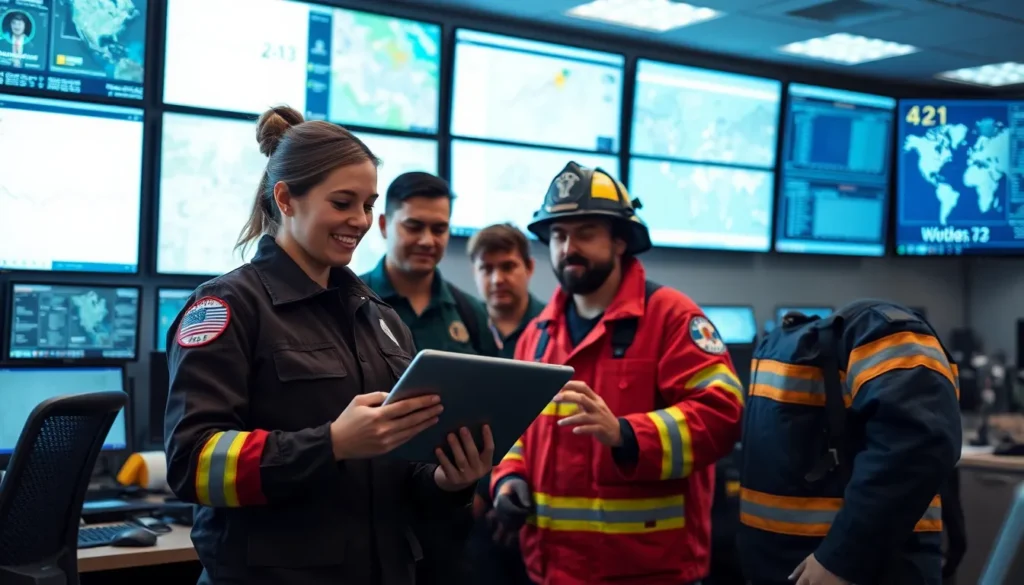Table of Contents
ToggleImagine a world where emergency responders have a super-smart sidekick that never sleeps, never gets tired, and can analyze data faster than a caffeinated squirrel. That’s the magic of AI in emergency services. From predicting disasters before they strike to optimizing response times, artificial intelligence is revolutionizing how first responders tackle crises.
Overview of AI in Emergency Services
AI significantly enhances emergency services by providing advanced tools for responders. Predictive analytics offers insights into potential disasters, allowing authorities to prepare effectively. Machine learning algorithms process vast amounts of data to identify patterns in emergencies, reducing response times. Real-time data processing supports situational awareness, enabling informed decision-making during crises.
Automated systems assist in dispatching resources swiftly and accurately. Chatbots and virtual assistants handle non-emergency inquiries, freeing human responders to focus on critical tasks. Geographic information systems (GIS) powered by AI facilitate efficient resource allocation based on geographic trends observed during emergencies.
During major incidents, AI enhances communication among various agencies. Data integration improves coordination and collaboration, ensuring all response teams operate with aligned objectives. Video analytics and image recognition technologies aid in assessing damage and identifying victims quickly.
Emergency service organizations increasingly adopt AI-driven tools for training purposes. Simulations prepare responders for various scenarios, improving their skills and readiness. Continuous learning models updated with recent data ensure that training remains relevant and effective.
By utilizing AI, emergency services become more proactive rather than reactive. This shift in strategy not only saves time but also potentially saves lives. As technology advances, the role of AI in enhancing response efficiency and crisis management capabilities will continue to grow. Incorporating AI into emergency services creates a smarter, more resilient system ready to tackle future challenges effectively.
Applications of AI in Emergency Services

AI serves multiple functions within emergency services, enhancing efficiency and effectiveness across various applications.
Predictive Analytics for Resource Allocation
Predictive analytics plays a crucial role in resource allocation during emergencies. These advanced AI systems analyze historical data, identifying patterns that indicate potential crisis situations. Authorities can deploy personnel and resources more effectively rather than relying on intuition. For example, weather-related data might signal a need for additional ambulances near flood-prone areas. This proactive approach reduces strain on emergency services, improving response times during critical incidents.
Enhancing Communication Through AI
AI significantly enhances communication between emergency responders and affected communities. Automated systems streamline information dissemination, ensuring that real-time updates reach those in need promptly. Various agencies can collaborate more efficiently, sharing crucial data and strategies that inform coordinated responses. Chatbots and virtual assistants also handle routine inquiries, freeing up human responders for urgent situations. Improved communication through AI fosters clarity and collaboration, vital during emergencies.
Benefits of AI in Emergency Services
AI introduces significant improvements in emergency services, optimizing response efficiency and enhancing overall effectiveness. The integration of AI technologies transforms various aspects of emergency response.
Improved Response Times
AI-driven systems drastically reduce response times. Data analysis contributes to identifying emergencies faster, allowing responders to act promptly. Predictive analytics identify potential incidents before they escalate, ensuring timely interventions. Real-time data processing helps emergency teams be more aware of evolving situations. Automated dispatch algorithms send resources more efficiently, minimizing delays in critical situations. The rapid availability of information supports quicker decision-making on the ground, making a substantial difference in outcomes.
Enhanced Decision Making
AI enhances decision-making capabilities for emergency responders. Systems provide insights based on historical data and current conditions, enabling informed choices during crises. Machine learning algorithms analyze patterns that guide strategies for resource deployment and prioritization. Enhanced situational awareness improves communication among team members and agencies involved. Visualization tools exhibit data clearly, allowing for faster assessments of complex scenarios. With AI, emergency services achieve a greater degree of confidence in their operational decisions, directly impacting public safety.
Challenges and Limitations
AI in emergency services faces several challenges and limitations despite its numerous advantages. These obstacles impact the overall effectiveness of AI-driven systems.
Data Privacy Concerns
Data privacy remains a significant concern for emergency services utilizing AI technologies. Collection of sensitive personal information can lead to breaches, and misuse poses risks to individuals’ security. Emergency organizations must ensure compliance with regulations such as HIPAA and GDPR. Trust becomes crucial as citizens must feel confident that their data is handled responsibly. Transparency regarding data use enhances public confidence and encourages cooperation during emergencies. Balancing data utilization with privacy rights presents a challenge that requires careful consideration.
Integration with Existing Systems
Integration of AI with existing emergency service systems presents hurdles that require attention. Many organizations operate on outdated technology that lacks compatibility with modern AI tools. Upgrading infrastructure demands both time and financial resources that may be limited. Training personnel to adapt to new technologies can also take considerable effort. Successful integration often relies on collaboration between technology providers and emergency services to customize solutions that meet specific needs. Ultimately, seamless integration is essential to maximize the benefits of AI in real-world applications.
Future Trends in AI for Emergency Services
Emerging trends indicate that AI will play an increasingly prominent role in emergency services. Enhanced predictive analytics capabilities empower responders to anticipate crises more effectively. These tools utilize vast datasets, identifying indicators of potential emergencies before they escalate.
Incorporating natural language processing will streamline communication between agencies and communities. AI systems can analyze real-time conversations, facilitating quicker and clearer information dissemination during incidents. Enhanced collaboration allows for faster responses and improved public safety outcomes.
Automated drones and robots are expected to revolutionize search and rescue operations. These technologies can access hard-to-reach areas and gather critical data without putting human responders at risk. Real-time video feeds and sensor data provided by these machines will enhance situational awareness.
AI-powered training simulations are becoming essential for emergency service organizations. By immersing responders in virtual environments, these systems prepare personnel for unpredictable scenarios, ensuring they remain adept at handling crises. Continuous learning models will refine the training experience, creating a robust workforce.
Data integration will take center stage as organizations begin merging AI tools with existing systems. This approach ensures seamless operations and maximizes the benefits of AI-driven resource allocation. Collaborations between technology providers and emergency services will facilitate this integration.
Investments in cybersecurity are vital as AI becomes more prevalent. Protecting sensitive data from potential breaches will foster public trust. Compliance with regulations like HIPAA and GDPR will support responsible data handling.
As the landscape of emergency services evolves, AI’s capacity for optimized response efficiency and strategic crisis management will expand. Future advancements promise a smarter, more resilient system ready to effectively tackle challenges.
The integration of AI in emergency services marks a significant leap towards more efficient and effective crisis management. As technology evolves, these intelligent systems will continue to enhance decision-making and streamline communication among responders and communities. The proactive approach enabled by AI not only optimizes resource allocation but also fosters a culture of preparedness.
While challenges such as data privacy and system integration remain, the potential benefits far outweigh the hurdles. Investment in AI-driven tools promises to create a more resilient emergency response framework. As organizations embrace these advancements, the future of emergency services looks brighter, ultimately leading to improved public safety and quicker response times in critical situations.




